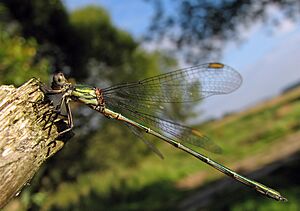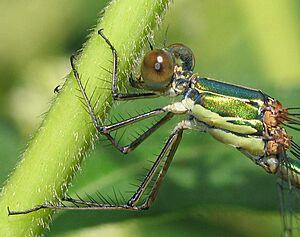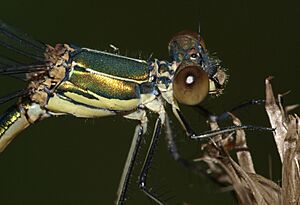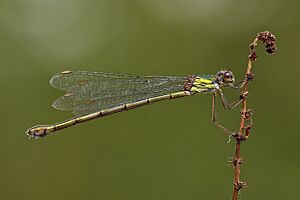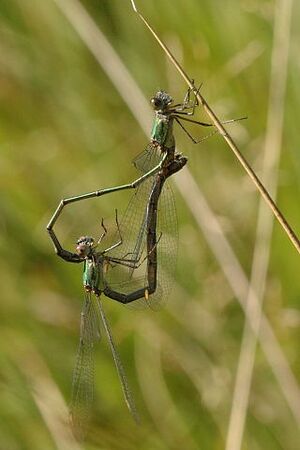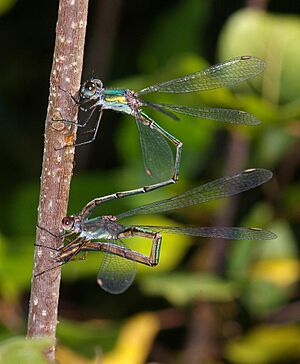Chalcolestes viridis facts for kids
Quick facts for kids Chalcolestes viridis |
|
|---|---|
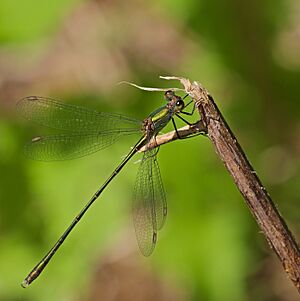 |
|
| Conservation status | |
| Scientific classification | |
| Synonyms | |
|
Lestes viridis Vander Linden, 1825 |
The willow emerald damselfly, also known as Chalcolestes viridis, is a beautiful insect. It belongs to the damselfly family called Lestidae. This damselfly has a shiny, metallic green body. When it rests, it holds its wings open, away from its body. You might also hear it called the green emerald damselfly or the western willow spreadwing. It has a long body and light brown spots on its wings. You can find it near calm water where trees hang over the edges.
Contents
What's in a Name? Understanding Damselfly Types
The Chalcolestes group of damselflies is different from the Lestes group. Scientists decided this because their young, called larvae, look different.
There's a very similar damselfly called C. parvidens. For a long time, people thought it was just a type of C. viridis. C. parvidens lives in places like Greece, Bulgaria, and Italy. Sometimes, both C. viridis and C. parvidens can be found in the same ponds.
They look very much alike, both as adults and as larvae. Even scientists find it hard to tell them apart just by looking. But by studying their proteins, scientists confirmed they are two different species. One small difference is that C. parvidens flies earlier in the year than C. viridis.
Where Willow Emerald Damselflies Live
You can find C. viridis across southern and central Europe. They also live in North Africa. In the eastern Mediterranean, another similar species, C. parvidens, takes its place. However, in some areas like Italy and the Balkans, both species can be found.
C. viridis lives on many Mediterranean islands. These include Corsica, Sicily, Mallorca, Menorca, and Ibiza. They also live in North Africa, Turkey, and the Middle East.
These damselflies like still or slow-moving water. This includes ditches, ponds, lakes, and canals. They especially like places with willow, alder, or birch trees hanging over the water. These trees are important for them to lay their eggs. Unlike many other damselflies, C. viridis and C. parvidens can even lay eggs in slow-moving water. The adult damselflies often rest in the bushes near the water.
Willow Emerald Damselflies in Britain
For a long time, the willow emerald damselfly was very rare in Britain. It was only seen occasionally. But now, it has started to live and breed there. It is quite common on the island of Jersey.
How to Spot a Willow Emerald Damselfly
It's very tricky to tell C. viridis apart from C. parvidens in nature. Both species are mostly metallic green, just like other Lestes damselflies. But they are usually bigger and darker. They don't have the powdery blue coating that many other Lestes damselflies have.
Look for these features:
- Their wing spots, called pterostigma, are light brown with a black outline.
- On their chest area, called the thorax, they have thin yellow lines. They also have a wider yellow stripe on each side, with a thin black line below it. The top edge of this yellow stripe is uneven.
- Both C. viridis and C. parvidens have a clear spur-like mark on the side of their thorax. This looks like a small spike.
Males
Male damselflies have a very long body, called the abdomen. Their lower claspers (parts at the end of the abdomen) are less than half the length of the upper ones. The upper claspers are a special pale yellow with black tips.
Females
Female damselflies have a special tool called an ovipositor. They use this to lay eggs. In C. viridis females, this ovipositor is longer than in another damselfly called Lestes dryas.
Life Cycle and Reproduction
Willow emerald damselflies usually fly from late August to October. But in the warmest parts of their range, they can appear as early as May and stay until November.
Mating and Egg Laying
Adult male damselflies find and protect small areas on shrubs and trees near the water. This is where they look for females. When a male finds a female, they mate in a special way. They form a "wheel position" with their bodies.
After mating, the pair flies together. The female lays her eggs into small cuts she makes in the bark of tree branches that hang over the water. This is different from many other damselflies, which lay eggs in plants under the water. Sometimes, where the eggs are laid, the tree bark can swell up and form oval bumps called galls.
Egg Development and Hatching
The eggs start to grow quickly for a few weeks. Then, they go into a special resting state called diapause. In this state, their growth slows down a lot. This is how the eggs survive the winter.
The next spring, the eggs hatch. The tiny larvae (young damselflies) drop into the water and start to grow. They grow very fast, and in just a couple of months, they become adult damselflies.
Adult Life
After becoming adults, the damselflies fly away from the water to mature. During this time, they cannot breed yet. They need time for their bodies to fully develop. This also stops them from breeding too early in the year. If females laid eggs when it was too warm, the eggs might hatch before winter. The young larvae would then die when the cold weather arrived. Once they are fully mature, the adults return to the water to start breeding.
See also



